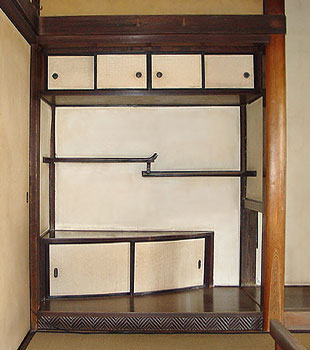|
||
 |
||

Old Yamamoto R{ house (Nagasaki)
@
(C)2001 Japanese Architecture and Art Net Users System.@No reproduction or republication without written permission.
fΪΜeLXgEΚ^ECXgΘΗASΔΜRecΜ³f‘»E]ΪπΦΆά·B
|
||||||
| @ | ||||||
| chigaidana@α’I | ||||||
| KEY WORD :@architecture / general terms | ||||||
| @ | ||||||
| Staggered shelves; considered part of the *shoin @ style decoration. One of the room ornaments which became established together with the decorative alcove *tokonoma °ΜΤ and attached desk *oshi-ita Β at the end of the Muromachi period, in the formal reception room *zashiki ΐ~. Usually located at the side of the decorative alcove. Two shelf boards are fixed at different levels, a small pillar *ebizuka CV© is inserted between them, and small edge-strips *fudegaeshi MΤ΅, are attached at the edge of the top shelf. A doored shelf is provided at the top or below the shelf boards, or both. Upper doored shelves are called tenbukuro Vά (see *fukurodana άI) and lower ones *jibukuro nά. Shelves in dwellings were originally practical, used to store personal belongings close at hand. In the Muromachi period, ornamental shelves began to be developed at Ashikaga Yoshimasa's «` (1436-90) mansions, Ogawagosho ¬μδ and Higashiyamadono Ra. The Muromachi period text OKAZARIKI δόL, describes room ornaments in those two mansions, with drawings of shelves together with oshi-ita, and descriptions of the methods of making shelves and ways of decorating. The chigaidana in the meeting room of Higashigoten δa, Ogawagosho, for example, was constructed at right angles to the oshi-ita, one bay wide (just under 2m), with upper and lower doored shelves, and there were two layers of staggered shelves (an arrangement called *shikiri chigaidana dΨα’I). On the top shelf was an incense burner, a tea container on a small tray, a small bowl on a tray, and on the bottom shelf were implements associated with the presentation of kaiseki ωΞ food (refined Kyoto cuisine). These were typical of items displayed on chigaidana, which also included inkstone *suzuri ₯ boxes and writing paper, books, and tea ceremony implements like teabowls *chawan q, and bamboo tea whisks. Around this time many art objects were imported from China, so chigaidana had an important function in displaying these. The oldest extant example of chigaidana can be seen in *Tougudou ° at Jishouji Ζ (1485), Kyoto. The chigaidana, half a bay wide, is built alongside the attached desk in a 4 1/2 mat room called Douninsai ―mΦ. This set of shelves has a bottom board ji-ita nΒ with a jibukuro on top of it, a staggered shelf in the middle and one shelf board on top. After the Momoyama period, shelves were usually constructed alongside the alcove, and there were many variations in the shape of the shelf boards. Tenbukuro and jibukuro were sometimes included. Shelves at Katsura Rikyuu j£{ (17c), and Shugakuin Rikyuu Cw@£{ (1659), both in Kyoto, for example, have complicated structures and are constructed with great technical skill. | ||||||
| @ | ||||||
 Old Yamamoto R{ house (Nagasaki)
|
||||||
@ |
||||||
| REFERENCES: | ||||||
| @ | ||||||
| EXTERNAL LINKS: | ||||||
| @@ | ||||||
| NOTES: | ||||||
| @ | ||||||
(C)2001 Japanese Architecture and Art Net Users System.@No reproduction or republication without written permission. fΪΜeLXgEΚ^ECXgΘΗASΔΜRecΜ³f‘»E]ΪπΦΆά·B |
||||||
| @ |